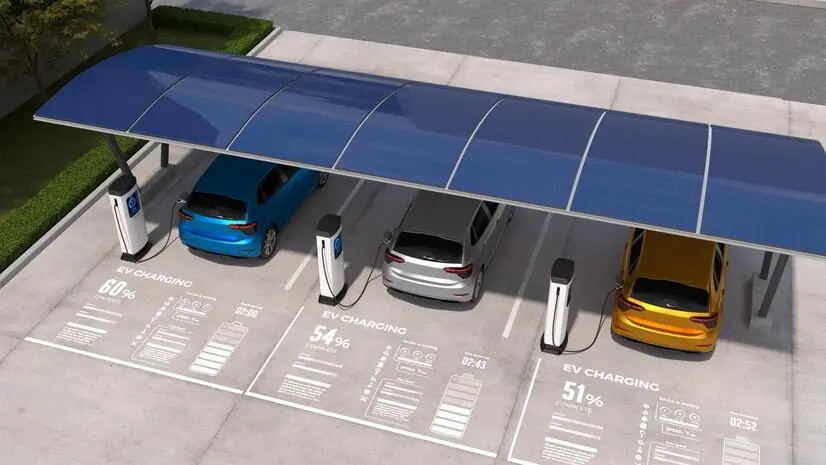Introduction
As a Professional EV Charger Manufacturer in China, Topper Company Provides Reliable Electric Vehicle Charging Stations and Comprehensive Charging Solutions.
The aviation industry significantly contributes to global greenhouse gas emissions, accounting for nearly 8% of all transportation-related emissions. While fully electric airliners remain a long-term goal, airports have an immediate opportunity to reduce their environmental impact by embracing electric vehicle (EV) technology. Transitioning airport fleet vehicles to EVs, installing EV charging infrastructure, and encouraging third-party contractors to adopt electric vehicles can significantly reduce tailpipe emissions. Moreover, providing EV charging stations for employees, passengers, rental customers, and the general public amplifies these efforts, positioning airports as leaders in sustainability and innovation.
This article explores the growing trend of airport EV charging, reviewing the types of charging solutions available, key considerations for implementation, and the broader impact on sustainability goals. From standard chargers to ultra-fast solutions, airports are uniquely positioned to support the EV revolution while advancing their environmental objectives.
Airport EV Charging Locations: Key Considerations
When planning EV charging installations, airports must consider several critical factors to optimize placement and functionality:
- Demand: Identify high-traffic areas where EV charging will be most utilized, such as long-term parking, employee parking, and rental car facilities.
- Sustainability Goals: Ensure alignment between EV infrastructure deployment and the airport’s broader environmental objectives.
- Parking Availability: Confirm adequate parking capacity to accommodate EVs alongside conventional vehicles.
- Power and Infrastructure Access: Assess electrical infrastructure to support charging stations without overloading the grid.
- Space for Hardware: Allocate sufficient space for chargers, cables, and ancillary equipment.
- Operational Efficiency: Avoid obstructing snow removal or impeding movement of large vehicles by proper charger placement.
- Accessibility: Design easy access and egress points to reduce congestion and enhance user convenience.
By addressing these considerations, airports can deliver a seamless and efficient EV charging experience for all users.
Types of EV Charging for Airports
Airports can deploy various EV charging solutions tailored to different user needs, including:
Standard Charging (Level 2 AC)
Ideal for extended parking durations, such as travelers leaving their EVs in long-term lots or employees charging during shifts. Standard charging typically delivers up to 22 kW, offering a cost-effective way to replenish batteries over several hours.
Fast Charging (DC)
Designed for shorter stays, fast chargers can recharge EV batteries within 30 minutes to 2 hours. They are well-suited for travelers making brief stops, often installed in short-term parking lots, rental car centers, and passenger drop-off zones.
Ultra-Fast Charging
Reducing charging time to as little as 20-30 minutes for an 80% battery charge, ultra-fast chargers benefit electric taxis, buses, and fleet vehicles requiring quick turnarounds. Strategic placement of ultra-fast chargers supports operational efficiency and growing demand.
Trends in Airport EV Charging
The development of airport EV infrastructure revolves around the Four Pillars of Airport EV Charging:
- EV Fleets: Airports are electrifying their own fleets—shuttle buses, baggage carts, and maintenance vehicles—reducing emissions and supporting sustainability goals. Dedicated charging in fleet parking areas ensures these vehicles remain operational and efficient.
- EV Rental Cars: Major rental companies now include electric vehicles in their fleets, increasing demand for charging stations at rental facilities. Airports installing chargers here enhance rental customer experience and encourage EV adoption.
- EV Drivers: More employees and passengers are driving EVs, pushing demand for accessible charging in both long-term and short-term parking areas.
- Overall EV Infrastructure: Airports are investing in comprehensive infrastructure including public charging stations, partnerships with utilities to upgrade grid capacity, and integrating renewable energy sources like solar panels to power chargers sustainably.
Broader Impact of Airport EV Charging
Installing EV charging infrastructure helps airports reduce tailpipe emissions, contributing to global climate goals and improving local air quality. Beyond environmental benefits, charging availability enhances passenger satisfaction, appealing to eco-conscious travelers.
Airports embracing EV technology also position themselves as industry leaders in sustainability and innovation, setting an example across sectors. With EV adoption accelerating worldwide, robust airport charging infrastructure will be vital to meeting future mobility needs.
Conclusion
Airport EV charging represents a pivotal step in aviation’s sustainability journey. By electrifying fleets, installing a range of charging stations, and supporting EV adoption among employees, travelers, and rental companies, airports can cut emissions while improving operational efficiency and customer experience.
From standard to ultra-fast charging, available solutions enable airports to serve diverse user needs and embrace a greener future. As global momentum shifts toward clean energy, airports have a unique opportunity to lead by example, demonstrating that sustainability and innovation go hand in hand in shaping the future of aviation.Know more about Google SEO Directory





Comments